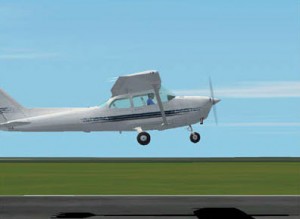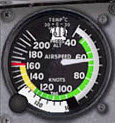It is taking me a while to solo, any advice?
Michael writes me asking:
Hi, I am currently working towards my PPL but am still not ready for solo despite having approximately 35 hours of flight time. The problem is the landing – the flare in particular – and I just do not seem to be getting it. Initially, I was not flaring at all and hitting the runway quite hard. Now I seem to flare too much and end up climbing again before finally landing quite far down the runway. I am training in a Piper Cadet and would appreciate any tips you can provide so that I can finally move towards solo flight. Many Thanks, Michael
Thanks for your question. First off, I wouldn’t worry about how much flight time you have accumulated so far. In fact, I’m sure your instructor has told you, “Everyone solos at different times” and that is very true. I’ve had some students who honestly could have soloed at 5 hours and others who I nervously signed off at 40+. There are so many factors that determine when someone is ready (mentally, physically, legally) going to solo.
The MOST important thing to remember when landing is to “RELAX“. That is not some famous aviation acronym, just some practical advice to take a deep breath, follow your instructor’s advice and land the airplane. I would guess that at this point, you are thinking much too hard about the landing. Because of your insecurities with the amount of time it has taken you to solo, you are overly focused in those last few precious seconds before touchdown. Just RELAX. That doesn’t mean don’t flare or flare slowly (you already knows what happens when you do that) but just be calm and smooth about it. Have confidence, you can do it. The feeling of the flare will come to you, just like it as to many others. Some of my worst landings happen when I’m trying too hard to get a “greaser” and some of my best landings come when I’m just doing what works. In other words, I perform better on landings, when I’m not thinking too much about it.
On a more practical note, one thing that helped me when I was learning to land was trying to visualize the landing from an outside perspective. I don’t know if you are familiar with flight simulator programs, but in Microsoft Flight Simulator you can select the “S” key on your keyboard and cycle through different views. When you are setting up for a landing, hit the “S” key in your mind and for a brief second, cycle the views till you get an outside view of your aircraft. Visualize the landing gear hanging below your airplane and what the correct pitch attitude would look like in order for the main gear to slowly come in contact with the surface. Visualize your landing and your success. This is very important to do. You have to see it in order to believe in it.

Trying Looking at your landings from another perspective

Maintaining the proper airspeed is important
Another thing, and one that I’m sure your instructor has taught you, is the important of a stabilized approach. Every good landing is preceded by a good approach. Make sure you are focused on making standard patterns and that at each stage of the pattern you are precisely where you should be in relation to airspeed, altitude and power. Know your approach speeds for each setting of flaps and your pattern segment (downwind, base, final). Good landings are possible out of a unstabilized approach, but not easy. Make it easy on yourself and begin with a stabilized approach to the airport.
Sometimes it is also helpful to fly with another instructor just to break through this kind of plateau. There might be one little instructional nugget that you are missing with your current instructor that another instructor could provide for you. Also, sometimes just hearing a different physical voice in your headset during your landing could be the difference. A good instructor will not fight you on this request.
Hang in there. Like I said before, every pilot solos at a different times and don’t become preoccuiped with thinking about how it might be taking you longer than someone else. Just relax and fly the airplane.
Fly Safe.


TheGimliGlider on Mar 08, 2009
Once upon a time I was eavesdropping on a conversation between one of my father’s colleagues, who is now a airline captain and instructor for our DC-10-30 fleet and a trainee:
“Let’s assume that you bought this aircraft (a piper cub) with your own hard-earned money, and that the landing gears cost 2000 dollars each, either to replace or buy them brand new.
Now, since a hard/abnormal landing creates pressure on the gears and ultimately causes them to weaken over time, wouldn’t you be extra careful during landing from now on, keeping in mind that the more smoother your landings are, the longer the gears will remain functional and require less repairs over time?
Imagine that the more smoother and perfect your landings are, the more money you are ultimately saving to spend towards your flight training in near future.”
The trainee now flies DC-10-30s as SIC. Here’s a video of the instructor and trainee shooting an approach to land, recorded by his daughter (I apologize in advance because they aren’t speaking in English): http://www.youtube.com/watch?v=VJqWi-SWVJQ
Martin Iglesias on Mar 08, 2009
I have to say that two things come to mind when I was doing my landings. The chief pilot at my school told me to keep flying the plane. Do whatever you can to not make it land. This depends on the length of the runways of course but its to say the plane will want to come down all on its own if you keep flaring gently as if you were flying to the end of the run way.
Not sure how your instructor taught you on power but if you feel like you are coming in too fast and you know you’ll hit the ground hard just pop in some power for less then a second or so and have the plane start to climb on its own and when you cut it you will have balanced out the vertical speed to really close to 0 and just float down those last inches. Same technique used for gusts when you come in for a landing pretty much and get launched up into the air.
Keep at it though. Right rudder too.
GirlsWithWings on Mar 08, 2009
I have been a pilot for 16 years (military and commercial airlines), so you’d think I’d have this all down by now, right – second nature? I still to this day talk to myself on short final in order to remind me to look down the whole runway! If you are looking right in front of you, you will be anticipating hitting the ground, but if you look down the runway your “angle” is greater, and you will be able to fly the airplane down to the ground. Almost make it a surprise when those gear touch. p.s. You’ll get it one day, and then lose it the next week. Then you re-learn to look down the runway, until the next time you forget or don’t think you need to anymore!
Rob Mark on Mar 08, 2009
I used to watch students struggle with the flare. Heck, I used to struggle with it myself until I learned a trick. I’d either smack the pavment or baloon back into the air when I got close.
An early instructor of mine asked me to talk him through a landing and tell him every second of the last five or so, precisely where my eyes were focused.
We found that the last few seconds I was looking at the runway right underneath the aircraft, a particularly difficult place from which to judge height.
He convinced me to start looking down the runway in the flare, right toward the end of the pavement in fact.
Once I began doing that, it became much easier for me – and later my students – to judge height above the runway and make the gentle changes needed for a decent touchdown.
Give it a try.
pilot2b on Mar 08, 2009
My nervous/ham-fisted/white knuckle death grip on the yoke hampered me in the beginning. I was over-controlling my flares and had trouble with holding an altitude. I was thinking in terms of overcoming “stiction” in the elevator controls and forcing it to move as I made adjustments. I switched to a very light fingertip grip and realized that simply lightly varying the pressure applied to the elevator will give the response needed.
I learned in motorcycling to “look where you want to go” because you do tend to go where you are looking. In landing an airplane, that translated (to me) to keeping my eyes on the touchdown area on the approach and gradually moving them up to the other end of the runway by the time the flare was underway, allowing the peripheral cues to do their thing.
Rob Mark on Mar 09, 2009
I used to watch students struggle with the flare. Heck, I used to struggle with it myself until I learned a trick. I’d either smack the pavment or baloon back into the air when I got close.
An early instructor of mine asked me to talk him through a landing and tell him every second of the last five or so, precisely where my eyes were focused.
We found that the last few seconds I was looking at the runway right underneath the aircraft, a particularly difficult place from which to judge height.
He convinced me to start looking down the runway in the flare, right toward the end of the pavement in fact.
Once I began doing that, it became much easier for me – and later my students – to judge height above the runway and make the gentle changes needed for a decent touchdown.
Give it a try.
Sorry… forgot to say great post – can’t wait to read your next one!
Danny V on Mar 09, 2009
I was in the same boat last September but, as was said above, when I started looking down the runway and imagining the wheels and their position relative to the ground, it all became easier.
Sylvia on Mar 13, 2009
When I did my PPL I was convinced that I was the slowest student ever – it was ages before I went solo and my boyfriend had started to ask if maybe something was wrong? He went solo at half the hours I did which didn’t help my self-esteem!
But I persevered and eventually it clicked into place. Don’t panic, you’ll get there.
Paul on Mar 20, 2009
Ok. Time for an admission. I haven’t been practicing “looking down the runway” as a professional pilot in a long time and it is funny but the other day while landing I tried this technique and I greased it on! Girls with Wings is right, easy to forget about but a tried-and-true method for reclaiming your landings. Try it out!
Jim G on Aug 05, 2009
For me, it was to relax and not get in a hurry. I had the notion that as soon as I flared my wheels should be touching. I later realized that the flare is just setting up the proper attitude so you’ll gently touchdown.
J.L.Lee ATP on Sep 22, 2009
You’ll get it, not to worry. As for me, I just close my eyes and try to run into something cheap!
Paul Potts on Jul 08, 2010
We found that the last few seconds I was looking at the runway right underneath the aircraft, a particularly difficult place from which to judge height.